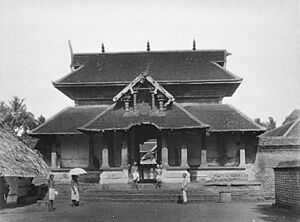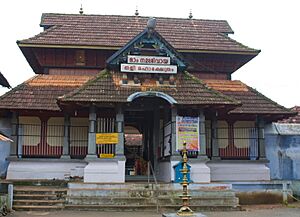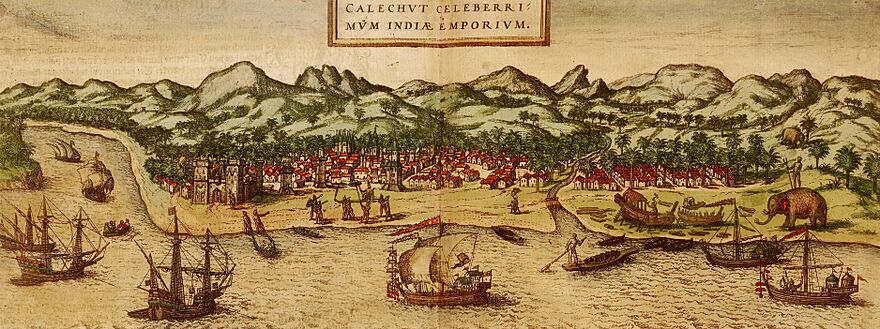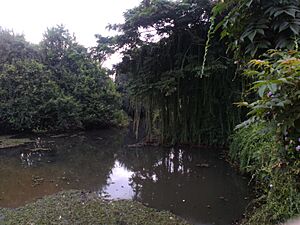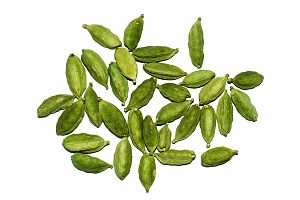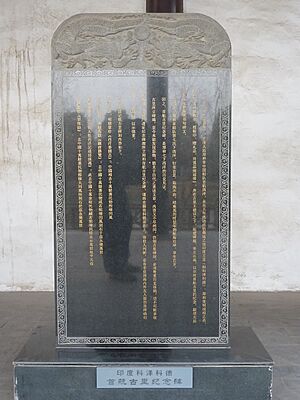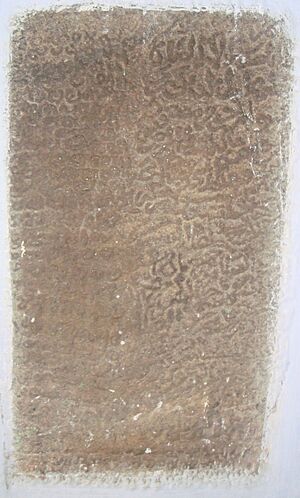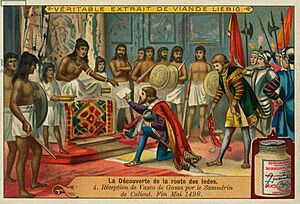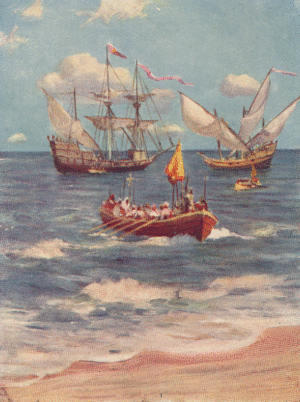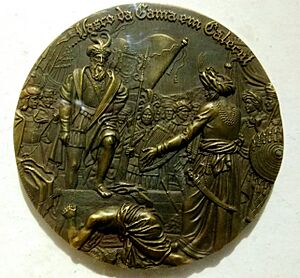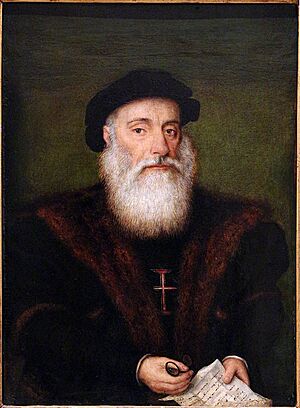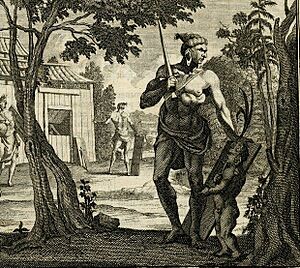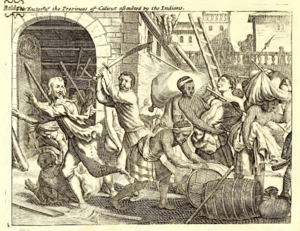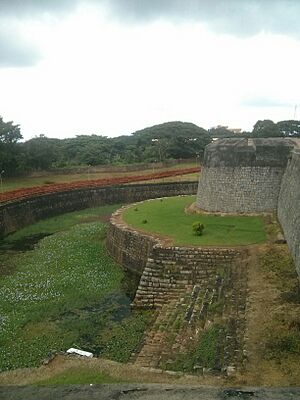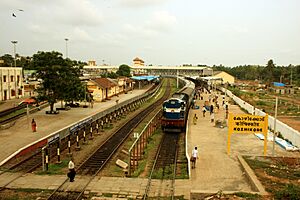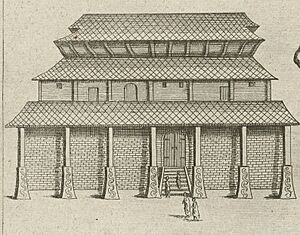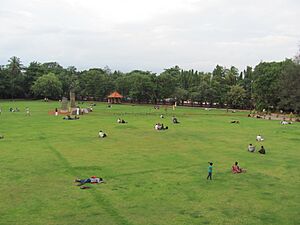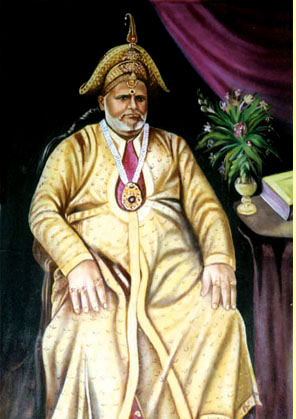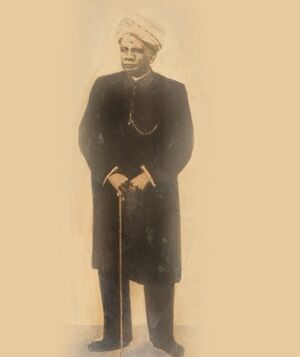Zamorin facts for kids
The Zamorin (also called Samoothiri) was the title for the ruler of the Kingdom of Calicut. This kingdom was located in the South Malabar region of India. The Zamorins came from the Nediyiruppu Swaroopam kingdom. They made Calicut one of the most important trading ports on India's southwest coast.
At their strongest, they ruled a large area. This area stretched from Kozhikode Kollam to the forests near Panthalayini Kollam (Koyilandy). The Zamorins belonged to a group called Eradi from the Samantan community. They were originally the chiefs of Eranad. The last Zamorin of Calicut tragically ended his own life. He burned his palace and himself when he learned that Hyder Ali had captured the nearby country of Chirackal.
Contents
- What Does the Name "Zamorin" Mean?
- Important Places of Power
- Family Rules and Who Becomes King
- A Look Back at History
- Relations with China
- Relations with the Portuguese
- Relations with the Dutch and English
- Mysore Takes Over and the Zamorin's Decline
- How the Kingdom Was Governed
- The Military
- List of Calicut Zamorins
- The Zamorin Family Today
What Does the Name "Zamorin" Mean?
The name "Zamorin" first appeared in writings by Ibn Battuta in 1342. In a Portuguese book from around 1516, the ruler's title was çamidre or zomodri. This came from the local Malayalam word sāmūtiri.
Some people once thought it meant "lord of the sea". This was because it sounded like the Sanskrit word for "sea". However, the name actually comes from Sanskrit words meaning "emperor". The full title was "august emperor". The Zamorins also used other titles in old records and treaties. One was "Punturakkon", meaning "Victor/Lord of Punthura". Another was "Kunnalakkon", meaning "Lord of Hills and Waves".
Important Places of Power
The Zamorins of Calicut had several important places where they ruled from. Ponnani was like a second home for them. Later, they also had seats of power in Trichur (Thrissur) and Cranganore (Kodungallur). The 147th Zamorin, Sree Manavedan Raja, was the last to control the Guruvayur Temple.
The main ports under the Zamorins in the late 1400s were Panthalayini Kollam and Calicut. The Zamorin made most of his money by taxing the spice trade through these ports. Smaller ports included Puthuppattanam, Parappanangadi, Tanur, Ponnani, Chetuva, and Kodungallur. The port of Beypore was famous for building ships.
Calicut: The City of Spices
- The port of Calicut was the most important for trade and power in Kerala. Other cities like Kollam, Kochi, and Kannur were less important.
- Travelers called Calicut by different names. Middle Eastern travelers called it "Kalikooth". For the Chinese, it was "Kalifo" or "Quli".
- In the Middle Ages, Calicut was known as the "City of Spices". It was a major hub for trading Asian spices.
- Calicut grew in importance after the 1200s. This was due to interest from Chinese and Middle Eastern traders. Also, the Zamorins became powerful rulers.
- The Zamorins' smart economic policies helped Calicut become very wealthy.
- A Muslim port official called the Shah Bandar Koya managed trade at Calicut. He oversaw customs, set prices, and collected taxes for the king.
- The famous fine cotton cloth called calico is thought to have gotten its name from Calicut.
Panthalayini Kollam: A Safe Harbor
- This port was also known as "Fandarina" by Ibn Battuta. The Chinese called it "Shaojunan".
- It was located north of Calicut, near a bay. This spot was perfect for ships to stay safe during the yearly monsoon rains.
- Many different merchants traded here. These included Chetti, Arab, and Jewish traders.
Family Rules and Who Becomes King
The royal family of the Zamorins followed a special system. The present king's sister's son would become the next king. This is called a matrilineal system. The Zamorin's direct sisters always married Nambudiri Brahmin men. This meant the king's family line was part Zamorin and part Nambudiri Brahmin.
The Zamorin's family was known as "Nediyirippu swaroopam". The oldest male member of this family became the Zamorin. There were five important positions in the royal line. These positions were based on age, with the oldest person getting the highest rank.
The five main positions were:
- 1st position: The Zamorin of Calicut.
- 2nd position: The Eralppadu. This person was next in line to the throne.
- 3rd position: The Munalpadu.
- 4th position: The Etatralpadu.
- 5th position: The Naduralpadu. This person was the former head of the family.
There were three main branches of the family:
- Kizhakke Kovilakam (Eastern Branch)
- Padinhare Kovilakam (Western Branch)
- Puthiya Kovilakam (New Branch)
The oldest female member of the family was called the Valiya Thamburatti. She also had her own property. However, women were not allowed to be the ruler of Calicut.
A Look Back at History
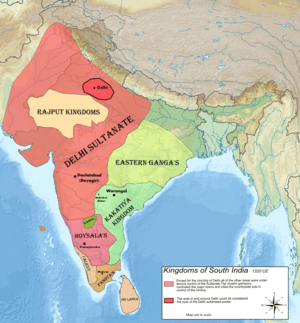
Old stories tell how the state of Calicut began. Two brothers from the Eradi family were brave warriors for the Cheras. After a big battle, the Chera king felt bad because he didn't give them any land. So, he gave the younger brother, Vikraman, a marshy piece of land called Kozhikode. He also gave him his broken sword and prayer conch. The king told him to conquer as much land as he could.
The Eradis then conquered nearby kingdoms and built a large state. To show respect to the Chera king, they used a symbol of two crossed swords with a broken conch and a lamp.
The port of Kozhikode was very important for trade in medieval Kerala. Traders from all over the world came here. In 1498, the Portuguese explorer Vasco da Gama arrived in Quilandy. This opened a direct sea route from Europe to South Asia. Calicut became a gateway for Arabs, Chinese, Portuguese, Dutch, and British traders.
The Portuguese tried to control the spice trade. But the Zamorin of Calicut and his navy, led by the Kunjali Marakkars, fought back. By the late 1500s, the Portuguese had taken over much of the spice trade. Then, the Dutch replaced the Portuguese in the 1600s, and later the British took over.
In 1755, Travancore defeated the Zamorin of Calicut in a battle. In 1766, Hyder Ali of Mysore conquered Calicut. After the Third Mysore War (1790–1792), the British East India Company took control of Malabar. By 1806, the Zamorin's power was gone. He became a pensioner of the company.
Early Rulers of Eranadu
The exact beginnings of the Zamorin of Calicut are not fully clear. Historians generally agree that the Eradis were originally independent rulers of the Eranadu region. This was part of the Kodungallur Chera kingdom. The chief of Eranad was called "Eralanadu Utaya".
Old inscriptions mention two titles for the rulers of Eranad: Manvepala Manaviyata and Manavikrama. Later, only Manavikrama, Manaveda, and Viraraya were used for male members of the royal family. The Zamorin was always known as Manavikrama.
One theory is that the Eradi ruler was a favorite of the last Chera king. He led the Chera army to victory against other forces. As a reward, the king gave him a small piece of land on the coast, which became Calicut. The Eradis then moved their main base to Calicut.
The Cheraman Sword
In the early 1500s, Duarte Barbosa wrote about the "Cheraman sword". This was one of the royal symbols of the Zamorin. The Zamorins worshipped this sword daily in their private temple. They especially honored it during coronations.
The original Cheraman sword was burned in a Dutch attack in 1670. A new sword was made in 1672 from pieces of the old one. The broken parts of the 1672 sword are still kept in a sealed copper case. They are worshipped daily in a temple connected to the Zamorin's palace.
Expanding the Kingdom
After getting Calicut, the Eradi rulers grew their power. The port of Calicut became very important. The Zamorin became one of the strongest chiefs in Kerala. Muslim sailors often helped him in his military campaigns.
Smaller kingdoms south of Calicut, like Beypore and Tanur, soon joined the Zamorin's kingdom. Other chiefs nearby also accepted the Zamorin's rule. The Zamorin also fought battles to gain control of coastal areas.
The Zamorin then focused on the Perar valley. This area was ruled by the Valluvakkonathiri. The Zamorin's main goal was to capture the sacred town of Thirunavaya. The Zamorin got involved in a local dispute between two groups of Brahmins. One group asked the Zamorin for help. In return, they promised to give him the port of Ponnani. The Zamorin gladly accepted this offer.
With help from his chiefs and the Muslim navy, the Zamorin's forces attacked. They fought fiercely, and eventually, the Zamorin's forces captured Thirunavaya. This was a big victory for Calicut.
The Zamorin continued to expand into Valluvanadu. He easily took over areas like Malappuram and Manjeri. He faced some tough resistance, but eventually, he gained more land. The Zamorin also settled Muslim families and loyal Hindu generals in the captured areas.
Taking Over Kochi
Calicut tried to conquer Perumpadappu, but they were defeated. After a period of peace, Calicut took over Nedunganadu without a fight. The chief of Nedunganadu surrendered. Then, Calicut captured more villages from Valluvanadu.
The Zamorin appointed the Eralppadu as the ruler of the southern Malabar region. The Perumpadappu ruler was forced to move his base further south to Kochi in 1405.
Calicut then conquered large parts of Kochi. The Zamorin used family feuds within the Kochi ruling family to his advantage. Many local rulers supported Calicut in this takeover. The Kochi chief was defeated, and his palace was taken. Kochi finally accepted Calicut's rule.
Calicut also brought Kolathunadu (Cannanore) under its control. The Zamorin occupied Pantalayini Kollam as a first step. The Kolathiri ruler quickly agreed to the Zamorin's terms. He gave up the occupied regions and some temple rights.
Relations with China
Chinese ships often visited Kerala ports like Kollam in the 800s and 900s. From the 1200s, Calicut became a major trading center where Middle Eastern and Chinese sailors met. Marco Polo visited Calicut in 1293–1294 and noted that the Chinese controlled much of the trade.
Zheng He (Cheng Ho), a famous Chinese admiral, visited Calicut many times in the early 1400s. He likely died in Calicut in 1433 during his seventh voyage.
The first Chinese expedition (1405–1407) focused on Calicut. Ambassadors from Calicut visited China, bringing gifts. Zheng He visited Calicut again on his second expedition (1408–1409). He formally recognized the Zamorin of Calicut. A special inscription was put up in Calicut to remember this event.
Chinese titles and gifts were given to the Zamorin. Zheng He's fleets visited Calicut several more times. Calicut rulers also sent many delegations to China, bringing gifts like horses and pepper.
Today, you can still see signs of Chinese trade in Calicut. These include a Silk Street, Chinese Fort ("Chinakotta"), Chinese Settlement ("Chinachery"), and Chinese Mosque ("Chinapalli").
Relations with the Portuguese
When Vasco da Gama landed in Calicut in 1498, it changed Asian history. Europeans began to take control of the Indian Ocean spice trade from Middle Eastern Muslims. The Zamorin welcomed the Portuguese at first. But the foreign merchants in Calicut were not friendly.
The Portuguese soon started fighting with the Zamorin and the Middle Eastern merchants. Calicut became a center of resistance. The Portuguese raided native ships. The Mappila and Marakkar traders fought against the Portuguese. Naval battles happened all along the coast. The Marakkars became the admirals of Calicut's navy and fought the Portuguese effectively.
The Kunjali Marakkars are famous for creating India's first naval defense. A book from the 1500s, Tuhfat Ul Mujahideen, tells the story of their fight against the Portuguese.
By the mid-1500s, the Portuguese had greatly reduced trade between Calicut and the Middle East. Kochi became the most important port in Kerala. The Portuguese wanted to break the trade monopoly of Venice and Egypt. The Egyptians and Ottomans saw the danger, but their own problems helped the Portuguese. In 1600, Ponnani Muhammed Kunjali Marakkar was executed with help from both Calicut and the Portuguese.
| Date | Event | ||||||||||||||||||||||||||||||||||||||||||||||||||||||||||||||||||||||||||||||||||||||||||||||||||||||||||||||||||||||||||||||||||||||||||||||||||||||||||
|---|---|---|---|---|---|---|---|---|---|---|---|---|---|---|---|---|---|---|---|---|---|---|---|---|---|---|---|---|---|---|---|---|---|---|---|---|---|---|---|---|---|---|---|---|---|---|---|---|---|---|---|---|---|---|---|---|---|---|---|---|---|---|---|---|---|---|---|---|---|---|---|---|---|---|---|---|---|---|---|---|---|---|---|---|---|---|---|---|---|---|---|---|---|---|---|---|---|---|---|---|---|---|---|---|---|---|---|---|---|---|---|---|---|---|---|---|---|---|---|---|---|---|---|---|---|---|---|---|---|---|---|---|---|---|---|---|---|---|---|---|---|---|---|---|---|---|---|---|---|---|---|---|---|---|---|
| May 1498 | Vasco da Gama arrives in Calicut. The Zamorin welcomes him. Da Gama's goods are not good for trade. He wants spices for his goods, but the Zamorin says he must pay with gold or silver and pay customs. After some trouble, da Gama leaves in August. | ||||||||||||||||||||||||||||||||||||||||||||||||||||||||||||||||||||||||||||||||||||||||||||||||||||||||||||||||||||||||||||||||||||||||||||||||||||||||||
| September 1500 | Pedro Álvares Cabral reaches Calicut. Gifts are exchanged, and a friendship treaty is made. Cabral gets permission to build a trading post. | ||||||||||||||||||||||||||||||||||||||||||||||||||||||||||||||||||||||||||||||||||||||||||||||||||||||||||||||||||||||||||||||||||||||||||||||||||||||||||
| December 1500 | Merchants in Calicut stop the Portuguese from getting spices. Cabral accuses Muslim merchants of buying all the spices. He seizes a Muslim ship. A riot breaks out, and about 50 Portuguese sailors are killed. The Portuguese then burn ten of the Zamorin's Muslim ships and bombard the port. | ||||||||||||||||||||||||||||||||||||||||||||||||||||||||||||||||||||||||||||||||||||||||||||||||||||||||||||||||||||||||||||||||||||||||||||||||||||||||||
| 24 December 1500 | The Portuguese, led by Cabral, arrive in Kochi. The Kochi Raja is under the Zamorin's rule. | ||||||||||||||||||||||||||||||||||||||||||||||||||||||||||||||||||||||||||||||||||||||||||||||||||||||||||||||||||||||||||||||||||||||||||||||||||||||||||
| January 1501 | The Portuguese make a treaty with Kochi. They can open a trading post. A Calicut fleet attacks Kochi, but Cabral chases them away. | ||||||||||||||||||||||||||||||||||||||||||||||||||||||||||||||||||||||||||||||||||||||||||||||||||||||||||||||||||||||||||||||||||||||||||||||||||||||||||
| December 1501 | Many Calicut ships attack Kochi. The Portuguese sink many of them. Muslims try to stop all trade with the Portuguese. | ||||||||||||||||||||||||||||||||||||||||||||||||||||||||||||||||||||||||||||||||||||||||||||||||||||||||||||||||||||||||||||||||||||||||||||||||||||||||||
| August 1502 | Vasco da Gama returns to India. He burns a ship full of Muslim pilgrims near Madayi. He then bombards Calicut, killing many people. The Portuguese also plunder rice shipments to starve Calicut. | ||||||||||||||||||||||||||||||||||||||||||||||||||||||||||||||||||||||||||||||||||||||||||||||||||||||||||||||||||||||||||||||||||||||||||||||||||||||||||
| November 1502 | Da Gama reaches Kochi and signs a trade treaty. He sets up a factory in Kochi. The Zamorin demands the Portuguese factors from Kochi, but Kochi refuses. | ||||||||||||||||||||||||||||||||||||||||||||||||||||||||||||||||||||||||||||||||||||||||||||||||||||||||||||||||||||||||||||||||||||||||||||||||||||||||||
| 1503 | The Portuguese crown the new ruler of Kochi, making him their ally. | ||||||||||||||||||||||||||||||||||||||||||||||||||||||||||||||||||||||||||||||||||||||||||||||||||||||||||||||||||||||||||||||||||||||||||||||||||||||||||
| March–April 1503 | Calicut forces attack Kochi, killing many. The Kochi chief escapes. Calicut forces burn Kochi. | ||||||||||||||||||||||||||||||||||||||||||||||||||||||||||||||||||||||||||||||||||||||||||||||||||||||||||||||||||||||||||||||||||||||||||||||||||||||||||
| September 1503 | Francisco de Albuquerque defeats Calicut forces at Kochi. He gets permission to build Fort Manuel, the first Portuguese fort in Asia. | ||||||||||||||||||||||||||||||||||||||||||||||||||||||||||||||||||||||||||||||||||||||||||||||||||||||||||||||||||||||||||||||||||||||||||||||||||||||||||
| January 1504 | Albuquerque leaves Malabar. He makes a short peace treaty with the Zamorin, but it is broken. | ||||||||||||||||||||||||||||||||||||||||||||||||||||||||||||||||||||||||||||||||||||||||||||||||||||||||||||||||||||||||||||||||||||||||||||||||||||||||||
| March–July 1504 | Pacheco defends Fort Manuel against a large Calicut army. He drives them back many times. The Zamorin gives up the attack. | ||||||||||||||||||||||||||||||||||||||||||||||||||||||||||||||||||||||||||||||||||||||||||||||||||||||||||||||||||||||||||||||||||||||||||||||||||||||||||
| September 1504 | Suarez de Menezes cannons Calicut. He raids and burns Kodungallur, sparing Christian homes but looting Jewish and Muslim ones. | ||||||||||||||||||||||||||||||||||||||||||||||||||||||||||||||||||||||||||||||||||||||||||||||||||||||||||||||||||||||||||||||||||||||||||||||||||||||||||
| March 1505 | A large Muslim fleet at Pantalayini Kollam is destroyed by the Portuguese. | ||||||||||||||||||||||||||||||||||||||||||||||||||||||||||||||||||||||||||||||||||||||||||||||||||||||||||||||||||||||||||||||||||||||||||||||||||||||||||
| February 1509 | The Portuguese defeat a combined fleet of Gujarat, Egypt, and Calicut at the Battle of Diu. This marks the start of Portuguese control over the spice trade. | ||||||||||||||||||||||||||||||||||||||||||||||||||||||||||||||||||||||||||||||||||||||||||||||||||||||||||||||||||||||||||||||||||||||||||||||||||||||||||
| 1510 | Governor Albuquerque and Fernando Coutinho attack Calicut. Coutinho is killed, and the Mananchira palace is burned. | ||||||||||||||||||||||||||||||||||||||||||||||||||||||||||||||||||||||||||||||||||||||||||||||||||||||||||||||||||||||||||||||||||||||||||||||||||||||||||
| 1513 | Albuquerque meets the Zamorin. They sign a treaty allowing the Portuguese to trade freely and build a fort in Calicut. | ||||||||||||||||||||||||||||||||||||||||||||||||||||||||||||||||||||||||||||||||||||||||||||||||||||||||||||||||||||||||||||||||||||||||||||||||||||||||||
| 1514–15 | Fort Calicut is built. The Zamorin sends envoys to the King of Portugal. | ||||||||||||||||||||||||||||||||||||||||||||||||||||||||||||||||||||||||||||||||||||||||||||||||||||||||||||||||||||||||||||||||||||||||||||||||||||||||||
| 1517 | An assassination attempt on the Zamorin at the Portuguese fort fails. | ||||||||||||||||||||||||||||||||||||||||||||||||||||||||||||||||||||||||||||||||||||||||||||||||||||||||||||||||||||||||||||||||||||||||||||||||||||||||||
| 1523 | Muslims, led by Kutti Ali, capture Portuguese ships and raid Kochi. | ||||||||||||||||||||||||||||||||||||||||||||||||||||||||||||||||||||||||||||||||||||||||||||||||||||||||||||||||||||||||||||||||||||||||||||||||||||||||||
| 1524 | The Zamorin's successor does not like the Portuguese. Kutti Ali's fleet anchors at Calicut. | ||||||||||||||||||||||||||||||||||||||||||||||||||||||||||||||||||||||||||||||||||||||||||||||||||||||||||||||||||||||||||||||||||||||||||||||||||||||||||
| December 1524 | Muslims, with Calicut's approval, attack Jews and Christians in Kodungallur. | ||||||||||||||||||||||||||||||||||||||||||||||||||||||||||||||||||||||||||||||||||||||||||||||||||||||||||||||||||||||||||||||||||||||||||||||||||||||||||
| February–March 1525 | A Portuguese navy raids Ponnani and Pantalayini Kollam, burning towns. Calicut forces besiege Fort Calicut. | ||||||||||||||||||||||||||||||||||||||||||||||||||||||||||||||||||||||||||||||||||||||||||||||||||||||||||||||||||||||||||||||||||||||||||||||||||||||||||
| October 1525 | The Viceroy relieves the fort. The fort is later abandoned and partly destroyed by the Portuguese. | ||||||||||||||||||||||||||||||||||||||||||||||||||||||||||||||||||||||||||||||||||||||||||||||||||||||||||||||||||||||||||||||||||||||||||||||||||||||||||
| 1531 | A peace treaty is signed between the Portuguese and the Zamorin. Fort Chaliyam is built, a strategic site near Calicut. | ||||||||||||||||||||||||||||||||||||||||||||||||||||||||||||||||||||||||||||||||||||||||||||||||||||||||||||||||||||||||||||||||||||||||||||||||||||||||||
| 1539 | Calicut makes an agreement with the Portuguese. The Zamorin and native Muslims grow apart. | ||||||||||||||||||||||||||||||||||||||||||||||||||||||||||||||||||||||||||||||||||||||||||||||||||||||||||||||||||||||||||||||||||||||||||||||||||||||||||
| 1540 | Pattu Kunjali Marakkar leads the Calicut navy. Chinna Kutti Ali seeks peace with the Portuguese. | ||||||||||||||||||||||||||||||||||||||||||||||||||||||||||||||||||||||||||||||||||||||||||||||||||||||||||||||||||||||||||||||||||||||||||||||||||||||||||
| 1550 | Battles near Kochi. The Portuguese destroy towns and kill people in Pantalayini Kollam. | ||||||||||||||||||||||||||||||||||||||||||||||||||||||||||||||||||||||||||||||||||||||||||||||||||||||||||||||||||||||||||||||||||||||||||||||||||||||||||
| 1571 | Fort Chaliyam surrenders to Calicut. The Zamorin destroys the fort. | ||||||||||||||||||||||||||||||||||||||||||||||||||||||||||||||||||||||||||||||||||||||||||||||||||||||||||||||||||||||||||||||||||||||||||||||||||||||||||
| 1573 | Pattu Kunjali Marakkar gets permission to build a fort and dockyard at Puthupattanam. | ||||||||||||||||||||||||||||||||||||||||||||||||||||||||||||||||||||||||||||||||||||||||||||||||||||||||||||||||||||||||||||||||||||||||||||||||||||||||||
| 1584 | Calicut's policy towards the Portuguese changes due to problems with the Marakkar. A treaty allows the Portuguese to build a factory at Ponnani. | ||||||||||||||||||||||||||||||||||||||||||||||||||||||||||||||||||||||||||||||||||||||||||||||||||||||||||||||||||||||||||||||||||||||||||||||||||||||||||
| 1591 | The Zamorin allows the Portuguese to build a factory and church in Calicut. | ||||||||||||||||||||||||||||||||||||||||||||||||||||||||||||||||||||||||||||||||||||||||||||||||||||||||||||||||||||||||||||||||||||||||||||||||||||||||||
| 1597 | The Zamorin becomes worried about the Marakkar's growing power. He styles himself "King of Muslims". | ||||||||||||||||||||||||||||||||||||||||||||||||||||||||||||||||||||||||||||||||||||||||||||||||||||||||||||||||||||||||||||||||||||||||||||||||||||||||||
| 1599 | The Zamorin and Portuguese agree to attack Kunjali Marakkar's fort together. | ||||||||||||||||||||||||||||||||||||||||||||||||||||||||||||||||||||||||||||||||||||||||||||||||||||||||||||||||||||||||||||||||||||||||||||||||||||||||||
| 1600 | The Portuguese and Zamorin's forces besiege Fort Marakkar. Marakkar IV surrenders and is executed in Goa. The Zamorin takes over the fort.
Relations with the Dutch and EnglishIn 1602, the Zamorin asked the Dutch for help against the Portuguese. He promised them a fort in Calicut. In 1604, a Dutch fleet arrived and signed a treaty with Calicut. This was the first treaty the Dutch East India Company made with an Indian ruler. They agreed to work together to remove the Portuguese from Malabar. However, the Dutch did not provide much military help. So, the Zamorin turned to the English. In 1615, Captain William Keeling and his ships arrived in Kozhikode. The British signed a trade treaty in 1616. They agreed to help Calicut expel the Portuguese from Kochi and Cranganore. The English set up a factory in Calicut, but the Zamorin found them unreliable too. The factory closed in 1617. Later, in 1661, Calicut joined the Dutch to defeat the Portuguese and Kochi. In 1755, Travancore defeated the Zamorin of Kozhikode. In 1795, the Dutch settlements in Malabar were given to the British. This was to prevent the French from taking them. Mysore Takes Over and the Zamorin's DeclineIn 1732, forces from Mysore first came to Kerala. They returned in 1735 and raided the Zamorin's borders in 1737. In 1745, Mysore fought three battles with Calicut. In 1756, they invaded Calicut for the fifth time. The chief of Palakkad had asked Mysore for protection. Hyder Ali of Dindigul sent his army to Kerala. The Zamorin tried to pay Hyder Ali to leave, but he couldn't. In 1766, 12,000 Mysore forces under Hyder Ali marched into Malabar. Muslims in Malabar and Ali Raja of Kannur helped the invaders. The Mysore army easily conquered northern Kerala. Hyder Ali defeated Calicut's warriors at Perinkolam Ferry. As Mysore approached Calicut city, the Zamorin sent his family to safety. To avoid the shame of surrendering, he set his palace on fire and died (April 27). Hyder Ali then added Malabar to his state. But soon, the Nair people rebelled against Mysore. Some members of the Zamorin family, like Krishna Varma and Ravi Varma, led the rebellion. The British East India Company helped them. In 1768, the Zamorin prince was restored to Calicut, agreeing to pay Mysore a yearly tribute. In 1774, Mysore forces again occupied Calicut. The prince fled. His nephew, Ravi Varma, continued the resistance. Ravi Varma helped the British take Calicut in 1782. But by a treaty in 1784, Malabar was given back to Mysore. In 1790, Lord Cornwallis invited Kerala chiefs to join him against Mysore. Prince Ravi Varma agreed to help. After the Third Mysore War (1790–1792), the British East India Company took control of Malabar. In 1792, the Zamorin was difficult during negotiations. So, some of his former lands were leased to another ruler. Eventually, the Zamorin's hereditary territory was leased back to him. He also temporarily had power over smaller rulers. But later, these arrangements ended. The Zamorin of Calicut became just a landlord receiving a payment called "malikhana". In 1800, Malabar was transferred to the Madras Presidency. In 1806, a new agreement defined the Zamorin's relationship with the British. How the Kingdom Was GovernedAt its peak, the Zamorin's kingdom stretched from Kollam to Panthalayini Kollam. Local chiefs, who were mostly independent, recognized the Zamorin as their overlord. These chiefs provided warriors to the Zamorin during battles. In return, the Zamorin protected them from enemies. Some local chiefs had their own ceremonies and even used the title "Raja". The Zamorin was helped by four main ministers called "Sarvadhi Karyakkar". There were also other ministers and temple officials. Ritual specialists like priests and astrologers were part of the royal household. Key Ministers
The Shahbandar KoyaThe Zamorin made most of his money by taxing the spice trade. But he let Muslim traders manage the actual trade. The Shahbandar Koya was a very important official in Calicut. He was usually the second most important person after the ruler. This Muslim merchant controlled trade at the port. He oversaw customs, set prices, and collected money for the king. He also collected brokerage fees and poll taxes. Tradition says a merchant from Oman convinced the Zamorin to conquer Valluvanadu. This merchant was then made the "Shahbandar". He was given the same rights as a Nair chief. He also had power over all Muslims in Calicut's market. Money and TradeThe main ways the Calicut kingdom made money were:
The Zamorin made most of his money from taxing the spice trade. Muslims, both local and from the Middle East, controlled most of the trade. Jews, Chettis, and Vanias also traded in Calicut. Foreigners dominated the profitable Indian Ocean spice trade. Goods traded across the Arabian Sea included spices like pepper, ginger, and cardamom. They also traded textiles and coconut products. Calicut imported gold, copper, silver, horses, and silk. Rice was a major import from other parts of India.
Calicut minted its own coins: Panam (gold), Taram (silver), and Kasu (copper). The person in charge of the mint was called the "Goldsmith of Manavikraman". The royal mint was destroyed in 1766. The MilitaryThe Zamorin's army was mostly made up of feudal levies. These were warriors provided by the vassal rulers and chiefs. The army had different ranks of commanders. Standing armies were kept in important places like Calicut and Ponnani. Dharmothu Panikkar was the main army instructor. Firearms were known before the Portuguese arrived. The Mappilas were the main musketeers. The Kunjali MarakkarsThe Kunjali Marakkars were the admirals of the Calicut Zamorin's navy in the 1500s. Mappila sailors were known for their naval guerrilla warfare. Their small, fast ships were a big threat to Portuguese shipping. However, their artillery was not as good, and they couldn't do large, organized operations. Historians believe the Marakkars mainly supplied food and spices. They were also traders of rice. In the early years of Portuguese presence, Muslim merchants in Kochi, like Cherina Mecar and Mamale Marakkar, supplied spices to the Portuguese. They also provided food for Portuguese settlements. By the 1520s, there were many fights between the Portuguese and the Mappilas. After several naval battles, Chinna Kutti Ali was forced to make peace in 1540. But the peace was broken. By the end of the 1500s, the Portuguese defeated the "Mappila challenge". Kunjali Marakkar IV was killed with the help of the Zamorin around 1600. The four most important Kunjali Marakkars were:
List of Calicut ZamorinsOld documents rarely mention the specific names of the Zamorins of Calicut. Mana Vikrama, Mana Veda, and Vira Raya were common names for male members. The Zamorin was always known as Manavikrama. First DynastyThe first ruling family's original home was Nediyiruppu. The head of the family was called Nediyiruppu Mutta Eradi. Later, the family moved to Kozhikode.
Second DynastyThe original ruling family ended with the 114th Zamorin. The 115th Zamorin was the oldest prince adopted from Nileshwaram in 1706.
The Zamorin Family TodayThe Zamorins of Calicut returned to Calicut from Travancore by 1800. During British rule, the Zamorins became "pensioned" landlords. They received a yearly payment called mali khana. After India became independent in 1947, the government took over these payments. The royal family has been trying to get a pension from the government for many years. In 2013, the Kerala government decided to give a monthly pension to members of the royal family. Today, the Zamorin of Calicut is the trustee for 46 Hindu temples in northern Kerala. These temples bring in a lot of money. The Zamorin also has a permanent seat on the Guruvayur Sree Krishna Temple's managing committee. The family manages the Zamorin's Guruvayurappan College and Zamorin's high school. The family has asked the government for help to protect their private collection of old items. This collection includes palm leaf manuscripts, swords, shields, and other valuable things. |



